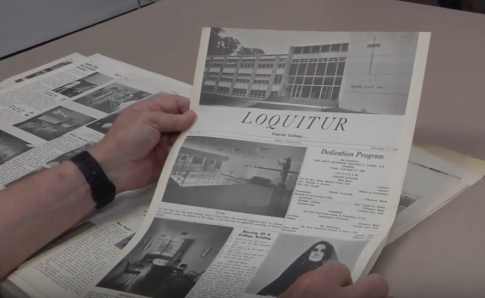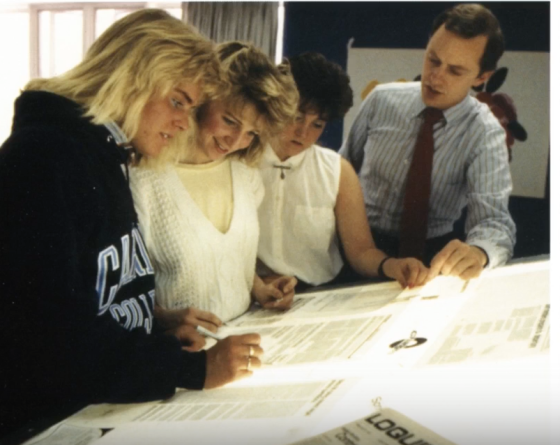Video by Anna Laquintano and Renata McGrath
It has become a tradition around Cabrini’s campus, every week since 1959, to look at a newsstand and find a freshly printed copy of the Loquitur newspaper. Yet, this year that tradition was broken. Rather than weekly, or even bi-weekly, the newspaper has started printing monthly editions.

What happened? Did the students become too lazy to print every week? No.
Just as has been happening behind the scenes for decades, the Loquitur has transitioned. This time even changing its name to Loquitur Media.
“It was pretty much the same when I started in ’72,” Jerry Zurek, Loquitur advisor and head of Cabrini’s communication department, said. “Always terrific students work for it, they’re hardworking.”
The Loquitur first got its start in 1959 with advisor and math professor Gerry Satlow at the head. The change in advisors is one of many that have lead up to what is currently Loquitur Media.
“So when we built the first com center over in the Widener building, the major innovation was every editor was going to have her own typewriter,” Zurek said. “And so that was a proud moment, every editor had her own typewriter on her desk.”
Zurek was also working with Loquitur during their transition into using computers for the first time, which became its own major process. The Loquitur had two of the very first IBM computers in order to start typesetting and printing through a floppy disk. After printing, they would use a fluorescent light board table and physically cut out each story, run it through a waxer and use a rolling pin to put it on the paper. And do not even mention a spelling mistake, which meant the individual letters had to be re-printed, cut, waxed and re-rolled.

Even at that point in time, the Loquitur was far ahead of other colleges and had a story printed about their typesetting work in Printer’s News.
So, now what is happening to the Loquitur? This year, the Loquitur took action to remain ahead of the curve again, now combining with Cabrini’s video news program, LOQation News.
“Dr. Zurek and I have always had the philosophy that we want to prepare students for the next thing that’s coming in the business so that they can go out and get jobs and they’re always one step ahead,” Cathy Yungmann, associate professor of communication and LOQation news advisor, said.
LOQation News first began in 2008 as a practicum video course proposed by some of Yungmann’s video students at the time.
“Students actually approached me and wanted to do an independent practicum project,” Yungmann said. “I said sure and we did it as a practicum and more people became interested in it, so then we turned it into a full-time course.”
LOQation News was not by any means the beginning of students’ involvement with video work at Cabrini. However, it was the first time they officially had a video news course offered. Previous to that, students would record events on campus on their own time, once remote cameras were affordable enough for the college to buy.
“We started doing video yearbooks in 1989,” Yungmann said. “The students would go out and record every single event that happened on campus the entire year and then put it together in an hour-and-a-half or two hour yearbook.”
The current manager of student media operations for the communication department, Jillian Smith, was one of the students who first came to Yungmann with the LOQation News idea.
“It was run just like a news show if you were to watch 6abc or NBC, any of those,” Smith said. “It covered local news, Cabrini news, things that were in the Loquitur that week, so it was just another outlet for us.”

LOQation News, now in its 9th season and combining with the Loquitur, has taken the same steps as the print newspaper and is filmed once a month rather than weekly.
Once again this brings up the question, have the students gotten lazier? No. Rather than printing and filming once a week, the students involved in Loquitur Media have begun posting multimedia pieces daily. While still producing monthly print and video news episodes, the students are publishing daily pieces with writing, photography, graphics and videos all surrounding the topics being covered.
“Before when it was a print edition, you would put the paper to bed and then you would go to bed, and then you would have a three day break or a four day break before you would start worrying about the next issue,” Zurek said. “News was happening all the time but reporters would only publish once a week, so it gave a distorted picture of how the world works. I think this is more realistic to how the world actually works.”
“A lot of our stories were old, so by the time those stories hit LOQation and then the video got edited and put up, everybody knew what we were talking about so it wasn’t fresh, there wasn’t really anything new or exciting,” Smith said.
Smith’s position in the department has been instrumental for this transition. “They hired me to kind of help converge the media so that all the medias kind of talked,” Smith said. “So now, instead of LOQation having its own show and its own agenda and Loquitur having its own paper and needing to fill 16 pages and then having their own stories and only sometimes working together, we’re now trying to get both of those media to work together and think of stories in terms of media rather than just as a written piece or a video.”
With the transition, the goal of keeping students ahead of the trends and ready for the workforce has remained in place.
“Our students are going to have a portfolio that contains all of the different types of communication media that an employer would be looking for,” Yungmann said. “So they can not only fill one position for a specific type of content creation, but then branch out and support all different kinds of media and all different kinds of content creation.”
“We’ve always had strong students in both video and writing, and now we’re trying to cross-train students so that they’re equally as strong in both areas as much as possible.” Zurek said.
While the plan has outlined many positives and strengths to the transition, it is a work in progress and most definitely has hit some bumps in the road, and will continue to do so. With this being a first in many ways for both the faculty and the students, many situations have to be handling on a case-by-case basis. At the same time, there were some difficulties even with the process of transitioning to begin with.
“It’s very awkward in a college situation to overcome the structure of the semester class and to try to combine that with immediate publication,” Yungmann said. “Students are taking other classes that they have other stuff to do and it’s very hard to find a time mechanism where Jerry [Zurek] and I can check through the media before it’s uploaded, which is what we’d like to do and if it’s constant uploading it’s like a nightmare for us to try to keep up with it.”
Though issues have come up, such as the struggle of teaching two separate courses (journalism and advanced video) with the same goal, and students committing to this full-time operation while also having other full-time responsibilities, it seems to be the consensus that this change was the correct move for the department to make.
“I think what’s been constant is that journalism requires really good writing and really inquisitive minds and the ability to relate to people. And so I think that was true in 1959 and 2016,” Zurek said. “It’s a difference in that we’re expecting more of students.”
“I hope it works,” Yungmann said.



